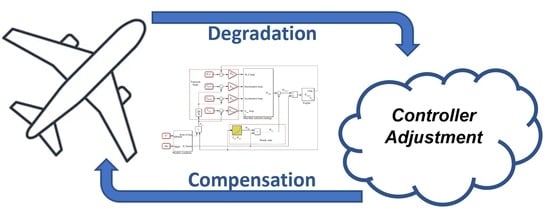Compressor Degradation Management Strategies for Gas Turbine Aero-Engine Controller Design
Abstract
:1. Introduction
2. Scientometric Analysis on Aero-Engine Degradation Management
- The first part is devoted to the scientometrics of gas turbines and degradation and accompanied by an inspection of the obtained results.
- In the second part, a series of analyses are performed on the design of gas turbine control systems in view of degradation, followed by an evaluation of the findings.
2.1. Scientometrics of Gas Turbines Degradation
2.2. Analysis and Evaluation
3. Clean Engine Modelling and Control
3.1. Clean Engine Modelling
3.2. Wiener Model
3.3. Clean Engine Controller Design
3.3.1. N-Dot Control Strategy
3.3.2. Gain Scheduling of the Controller
4. Degradation Modelling
4.1. Modelling of the Degraded Engine
4.2. Performance Change of the Degraded Engine
5. Degradation Management Strategies
5.1. Strategies of Adjustment for the Controller of the Degraded Engine
5.2. Adjustment for the Controller
6. Results Analysis
7. Conclusions
Author Contributions
Funding
Institutional Review Board Statement
Informed Consent Statement
Data Availability Statement
Acknowledgments
Conflicts of Interest
Nomenclature
| F | Thrust |
| FMU | Fuel metering unit |
| (rpm) | Physical rotor speed |
| Corrected rotor speed | |
| Acceleration N-dot demand | |
| Deceleration N-dot demand | |
| (rpm) | Max rotor speed limit |
| PI | Proportional Integral |
| PLA | Power lever angle |
| (K) | Turbine outlet temperature |
| (K) | Max turbine temperature limit |
| Component efficiency of the clean engine | |
| Component efficiency of the degraded engine | |
| Percent of degradation of component efficiency |
References
- Naeem, M.; Singh, R.; Probert, D. Consequences of aero-engine deteriorations for military aircraft. Appl. Energy 2001, 70, 103–133. [Google Scholar] [CrossRef]
- Darecki, M.; Edelstenne, C.; Enders, T.; Fernandez, E.; Hartman, P.; Herteman, J.P.; Kerkloh, M.; King, I.; Ky, P.; Mathieu, M.; et al. Flightpath 2050, Europe’s Vision for Aviation Maintaining Global Leadership & Serving Society’s Needs; Report of the High Level Group on Aviation Research, Directorate-General for Research and Innovation Directorate-General for Mobility and Transport; Publications Office of the European Union: Brussels, Belgium, 2011. [Google Scholar]
- Austin Spang, H.; Brown, H. Control of jet engines. Control. Eng. Pract. 1999, 7, 1043–1059. [Google Scholar] [CrossRef]
- Jafari, S.; Nikolaidis, T. Meta-heuristic global optimization algorithms for aircraft engines modelling and controller design; A review, research challenges, and exploring the future. Prog. Aerosp. Sci. 2019, 104, 40–53. [Google Scholar] [CrossRef]
- Csank, J.; May, R.D.; Litt, J.S.; Guo, T.H. Control design for a generic commercial aircraft engine. In Proceedings of the 46th AI-AA/ASME/SAE/ASEE Joint Propulsion Conference and Exhibit, Nashville, TN, USA, 25–28 July 2010. [Google Scholar]
- Martin, S.; Wallace, I.; Bates, D.G. Development and validation of a civil aircraft engine simulation model for advanced controller design. J. Eng. Gas Turbines Power 2008, 130, 1–15. [Google Scholar] [CrossRef] [Green Version]
- Litt, J.; Frederick, D.; Guo, T.-H. The Case for Intelligent Propulsion Control for Fast Engine Response. In Proceedings of the AIAA Infotech Aerospace Conference and AIAA Unmanned. Unlimited Conference, Seattle, WA, USA, 6–9 April 2009. [Google Scholar] [CrossRef] [Green Version]
- Csank, J.T.; May, R.D.; Litt, J.S.; Guo, T.H. A Sensitivity Study of Commercial Aircraft Engine Response for Emergency Situations; TM-2011-217004; NASA Glenn Research Center: Cleveland, OH, USA, 2011.
- Dang, W.; Wang, X.; Wang, H.; Li, Z.; Li, H. Design of transient state control mode based on rotor acceleration. In Proceedings of the 2015 12th International Bhurban Conference on Applied Sciences and Technology, IBCAST 2015, Islamabad, Pakistan, 13–17 January 2015; pp. 126–132. [Google Scholar]
- Litt, J.S.; Parker, K.I.; Chatterjee, S. Adaptive gas turbine engine control for deterioration compensation due to aging. In Proceedings of the International Symposium on Air Breathing Engines ISABE 2003, Cleveland, OH, USA, 31 August–5 September 2003; pp. 1–9. [Google Scholar]
- Luppold, R.; Roman, J.; Gallops, G.; Kerr, L. Estimating in-flight engine performance variations using Kalman filter concepts. In Proceedings of the 25th Joint Propulsion Conference, Monterey, CA, USA, 12–16 July 1989. [Google Scholar] [CrossRef]
- Wei, Z.; Jafari, S.; Zhang, S.; Nikolaidis, T. Hybrid Wiener model: An on-board approach using post-flight data for gas turbine aero-engines modelling. Appl. Therm. Eng. 2020, 184, 116350. [Google Scholar] [CrossRef]
- Aryadoust, V. A review of comprehension subskills: A scientometrics perspective. System 2019, 88, 102180. [Google Scholar] [CrossRef]
- Mohammadi, S.J.; Fashandi, S.A.M.; Jafari, S.; Nikolaidis, T. A scientometric analysis and critical review of gas turbine aero-engines control: From Whittle engine to more-electric propulsion. Meas. Control. 2020, 54, 935–966. [Google Scholar] [CrossRef]
- Wuni, I.Y.; Shen, Q.; Osei-Kyei, R. Scientometric review of global research trends on green buildings in construction journals from 1992 to 2018. Energy Build. 2019, 190, 69–85. [Google Scholar] [CrossRef]
- Martinez, S.; Delgado, M.D.M.; Marin, R.M.; Alvarez, S. Science mapping on the environmental footprint: A scientometric analysis-based review. Ecol. Indic. 2019, 106, 105543. [Google Scholar] [CrossRef]
- Burnham, J.F. Scopus Database: A Review; Biomedical Digital Libraries, Springer Nature: Basingstoke, UK, 2006; Volume 3, pp. 1–8. [Google Scholar]
- Liu, Z.; Gou, L.; Fan, D. Aeroengine gain-scheduling control based on performance degradation with constrained control inputs. In Proceedings of the 11th International Conference on Mechanical and Aerospace Engineering (ICMAE), Athens, Greece, 14–17 July 2020; pp. 122–128. [Google Scholar] [CrossRef]
- Shan, R.-B.; Li, Q.-H.; Pang, S.-W.; Ni, B. Acceleration performance recovery control for degradation aero-engine. Tuijin Jishu/J. Propuls. Technol. 2020, 41, 1152–1158. [Google Scholar]
- Zaccaria, V.; Ferrari, M.L.; Kyprianidis, K. Adaptive control of micro gas turbine for engine degradation compensation. In Proceedings of the Turbo Expo: Power for Land, Sea, and Air. American Society of Mechanical Engineers, Phoenix, AZ, USA, 17–21 June 2019; Volume 58608, p. V003T06A004. [Google Scholar] [CrossRef]
- Gou, L.; Liu, Z.; Fan, D.; Zheng, H. Aeroengine robust gain-scheduling control based on performance degradation. IEEE Access 2020, 8, 104857–104869. [Google Scholar] [CrossRef]
- Zheng, Q.; Du, Z.; Fu, D.; Hu, Z.; Zhang, H. Direct thrust inverse control of aero-engine based on deep neural network. Int. J. Turbo Jet-Engines 2019. [Google Scholar] [CrossRef]
- Yonghua, W.; Keyi, J.; Tao, S.; Xinyi, Y.; Xiuxia, W. The mitigation control for engine performance deterioration. In Proceedings of the World Congress on Intelligent Control and Automation (WCICA), Guilin, China, 12–15 June 2016; pp. 280–283. [Google Scholar]
- Zhao, K.; Li, D.; Li, B.-W. Research on performance recovery for engine performance deterioration. Tuijin Jishu/J. Propuls. Technol. 2015, 36, 1560–1566. [Google Scholar]
- Guo, Y.Q.; Chen, X.L.; Du, X.; He, X.D. Adaptive life extending control of aircraft engine. In Proceedings of the 50th AI-AA/ASME/SAE/ASEE Joint Propulsion Conference, Cleveland, OH, USA, 28–30 July 2014; p. 8. [Google Scholar]
- Chen, X.-L.; Guo, Y.-Q.; Du, X. Adaptive life extending control of aircraft engine in whole life. Tuijin Jishu/J. Propuls. Technol. 2014, 35, 107–114. [Google Scholar]
- Li, Y.-B.; Li, Q.-H.; Huang, X.-H.; Zhao, Y.-P. Performance deterioration mitigation control of aero-engine. Hangkong Dongli Xuebao/J. Aerosp. Power 2012, 27, 930–936. [Google Scholar]
- Turso, J.A.; Litt, J.S. Toward an intelligent, deterioration accommodating controller for aging turbofan engines. Aeronaut. J. 2008, 112, 641–651. [Google Scholar] [CrossRef]
- Litt, J.S.; Sowers, T.S. Evaluation of an outer loop retrofit architecture for intelligent tbrbofan engine thrust control. In Proceedings of the AIAA/ASME/SAE/ASEE 42nd Joint Propulsion Conference, Sacramento, CA, USA, 9–12 July 2006; pp. 7496–7523. [Google Scholar]
- Fuller, J.W.; Kumar, A.; Millar, R.C. Adaptive model based control of aircraft propulsion systems: Status and outlook for naval aviation applications. In Proceedings of the Turbo Expo: Power for Land, Sea, and Air, Barcelona, Spain, 8–11 May 2006; pp. 507–513. [Google Scholar] [CrossRef]
- Yuan, C.-F.; Yao, H.; Liu, Y. On-board adaptive model based control of aero-engine. Tuijin Jishu/J. Propuls. Technol. 2006, 27, 354–358. [Google Scholar]
- Litt, J.S.; Turso, J.A.; Shah, N.; Shane Sowers, T.; Karl Owen, A. A demonstration of a retrofit architecture for intelligent control and diagnostics of a turbofan engine. In Proceedings of the InfoTech at Aerospace: Advancing Contemporary Aerospace Technologies and Their Integration, Arlington, VA, USA, 26–29 September 2005; pp. 21–38. [Google Scholar]
- Kurd, Z.; Kelly, T.P. Using Safety Critical Artificial Neural Networks in Gas Turbine Aero-Engine Control; Springer: Berlin, Germany, 2005; pp. 136–150. [Google Scholar]
- Turso, J.A.; Litt, J.S. Intelligent, robust control of deteriorated turbofan engines via linear parameter varying quadratic lyapunov function design. In Proceedings of the AIAA 1st Intelligent Systems Technical Conference, Chicago, IL, USA, 20–22 September 2004; pp. 678–691. [Google Scholar]
- Chatterjee, S.; Litt, J. Online model parameter estimation of jet engine degradation for autonomous propulsion control. In Proceedings of the AIAA Guidance, Navigation, and Control Conference and Exhibit, Austin, TX, USA, 11–14 August 2003. [Google Scholar] [CrossRef]
- van Eck, N.J.; Waltman, L. Software survey: VOSviewer, a computer program for bibliometric mapping. Scientometrics 2010, 84, 523–538. [Google Scholar] [CrossRef] [PubMed] [Green Version]
- Roux, E. Turbofan and Turbojet Engines: Database Handbook; Editions Elodie Roux: Blagnac, France, 2007. [Google Scholar]
- Pilidis, P.; Maccallum, N.R.L. A general program for the prediction of the transient performance of gas turbines. In Proceedings of the ASME 1985 International Gas Turbine Conference and Exhibit, Houston, TX, USA, 18–21 March 1985. 85-GT-209, V001T03A053. [Google Scholar] [CrossRef]
- Kulikov, G.G.; Thompson, H.A. Dynamic Modeling of Gas Turbines: Identification, Simulation, Condition Monitoring and Optimal Control; Springer: London, UK, 2003. [Google Scholar]
- Walsh, P.P.; Fletcher, P. Gas Turbine Performance, 2nd ed.; Blackwell: Oxford, UK, 2004. [Google Scholar]
- Richter, H. Advanced Control of Turbofan Engines; Springer: New York, NY, USA, 2012. [Google Scholar] [CrossRef]
- Liu, Y.; Jafari, S.; Nikolaidis, T. Advanced optimization of gas turbine aero-engine transient performance using linkage-learning genetic algorithm: Part II, optimization in flight mission and controller gains correlation development. Chin. J. Aeronaut. 2021, 34, 568–588. [Google Scholar] [CrossRef]
- Litt, J.S.; Simon, D.L.; Garg, S.; Guo, T.-H.; Mercer, C.; Millar, R.; Behbahani, A.; Bajwa, A.; Jensen, D.T. A survey of intelligent control and health management technologies for aircraft propulsion systems. J. Aerosp. Comput. Inf. Commun. 2004, 1, 543–563. [Google Scholar] [CrossRef] [Green Version]
- Li, Y.G. Gas turbine performance and health status estimation using adaptive gas path analysis. J. Eng. Gas Turbines Power 2010, 132, 1–9. [Google Scholar] [CrossRef]
- Saatlou, E.N.; Kyprianidis, K.; Sethi, V.; O Abu, A.; Pilidis, P. On the trade-off between minimum fuel burn and maximum time between overhaul for an intercooled aeroengine. Proc. Inst. Mech. Eng. Part G J. Aerosp. Eng. 2014, 228, 2424–2438. [Google Scholar] [CrossRef]
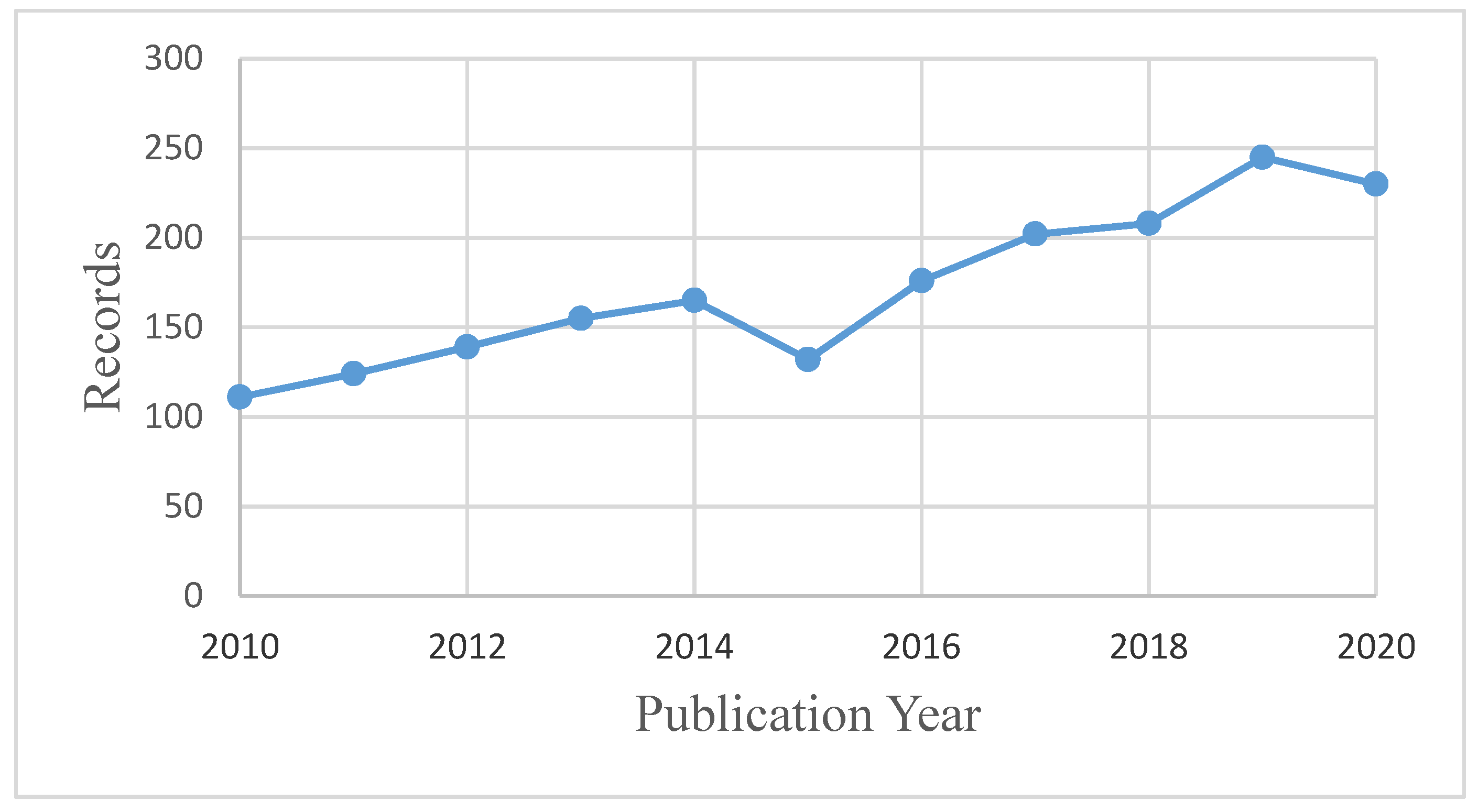


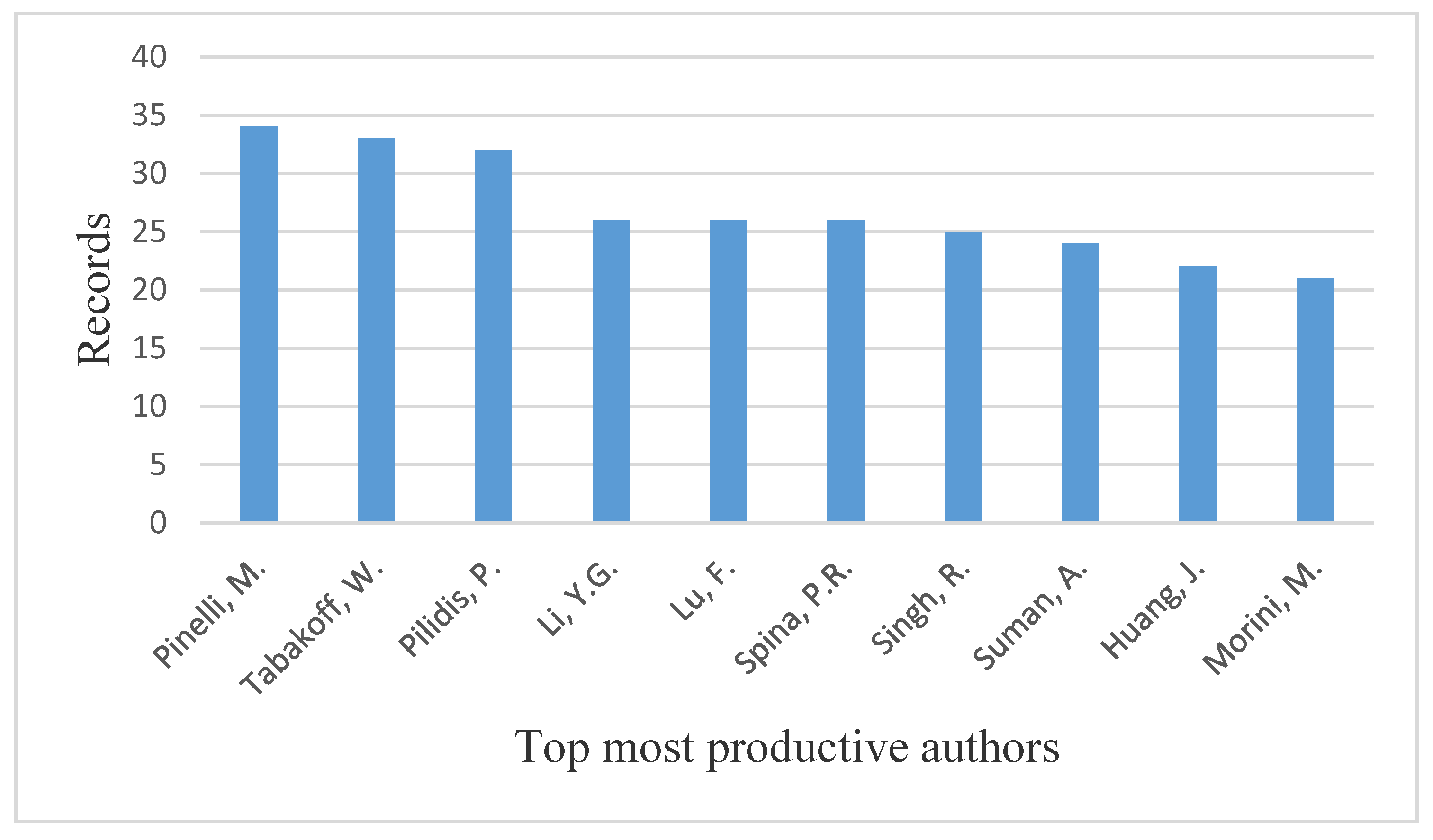


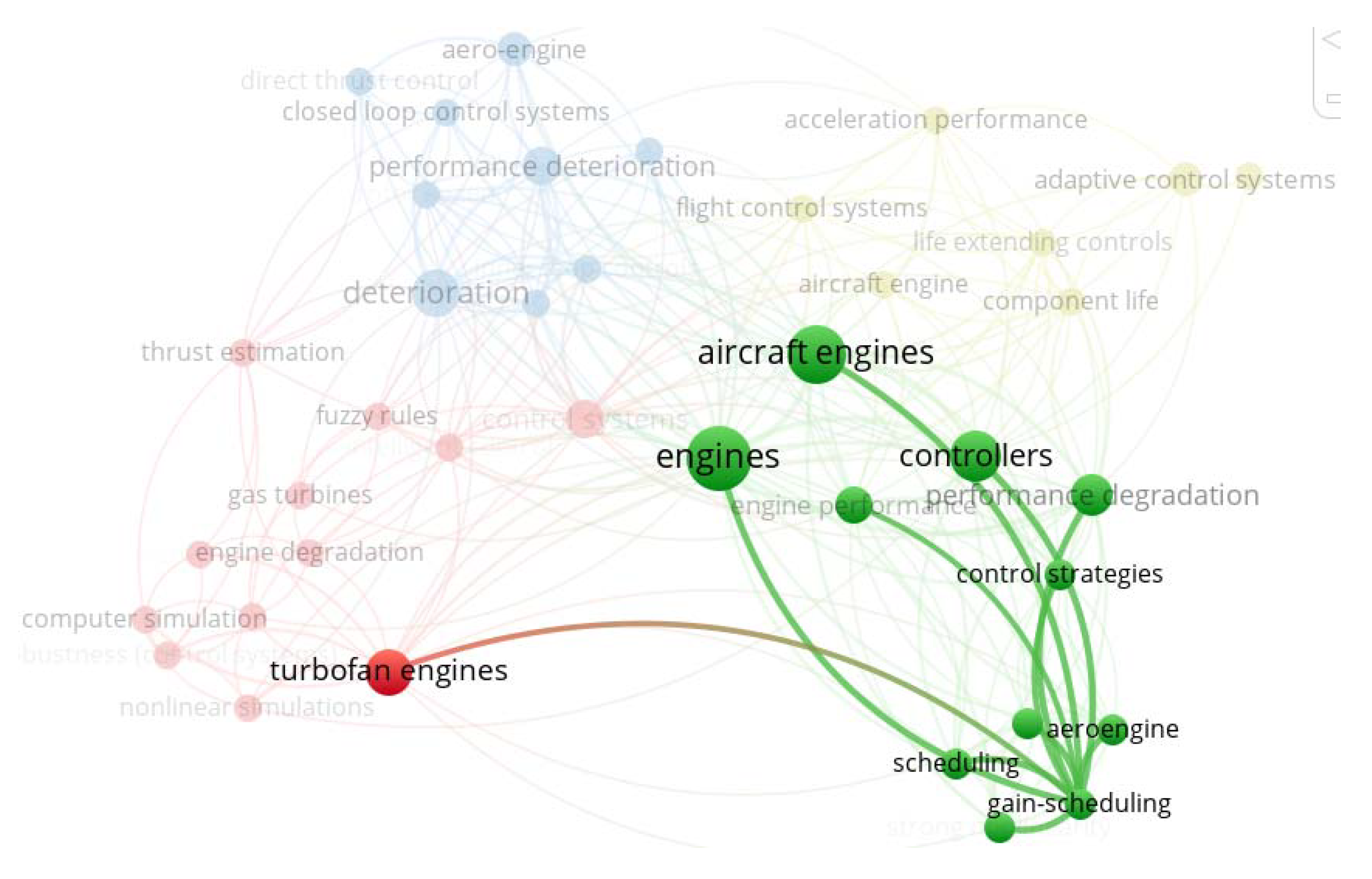
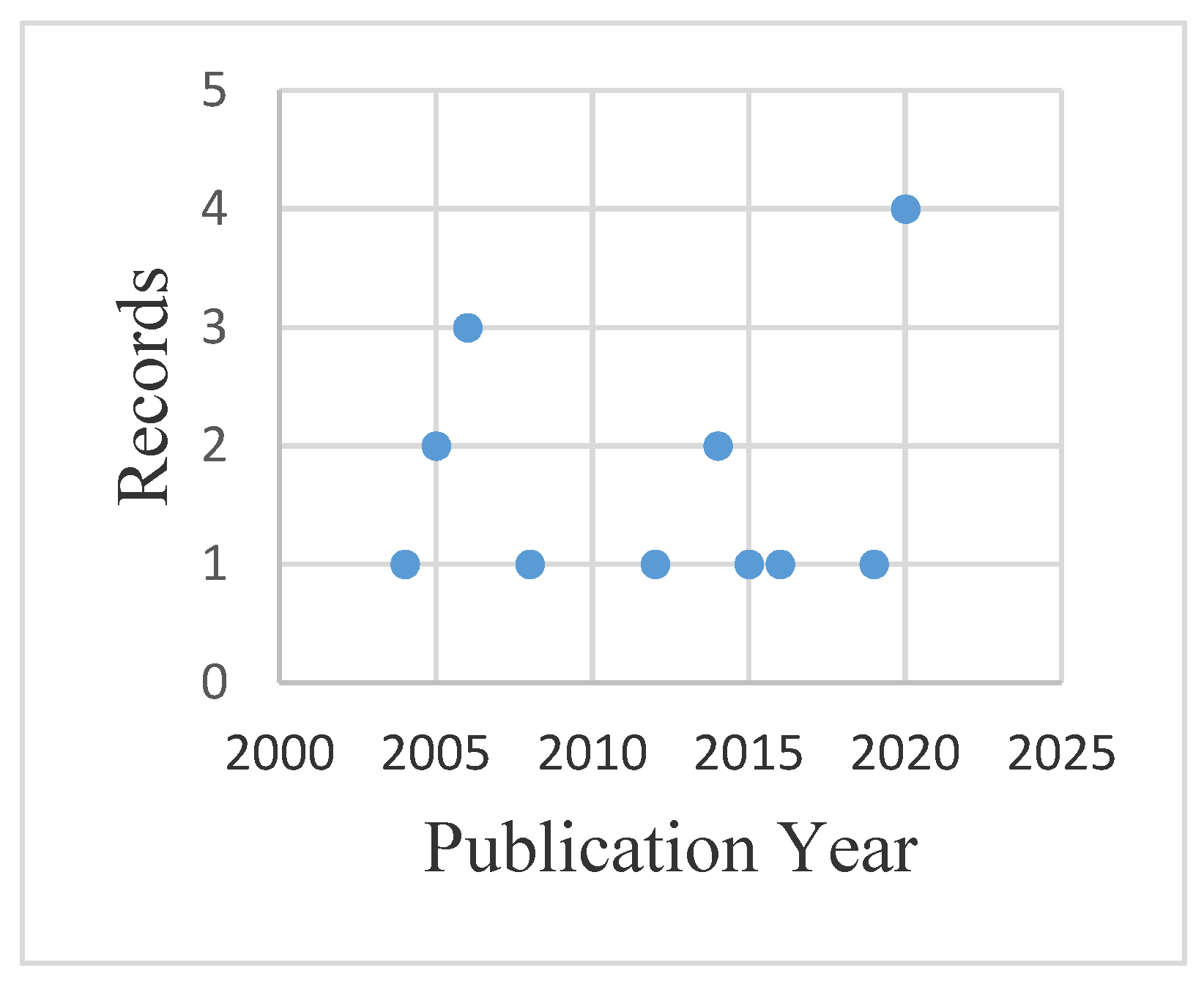


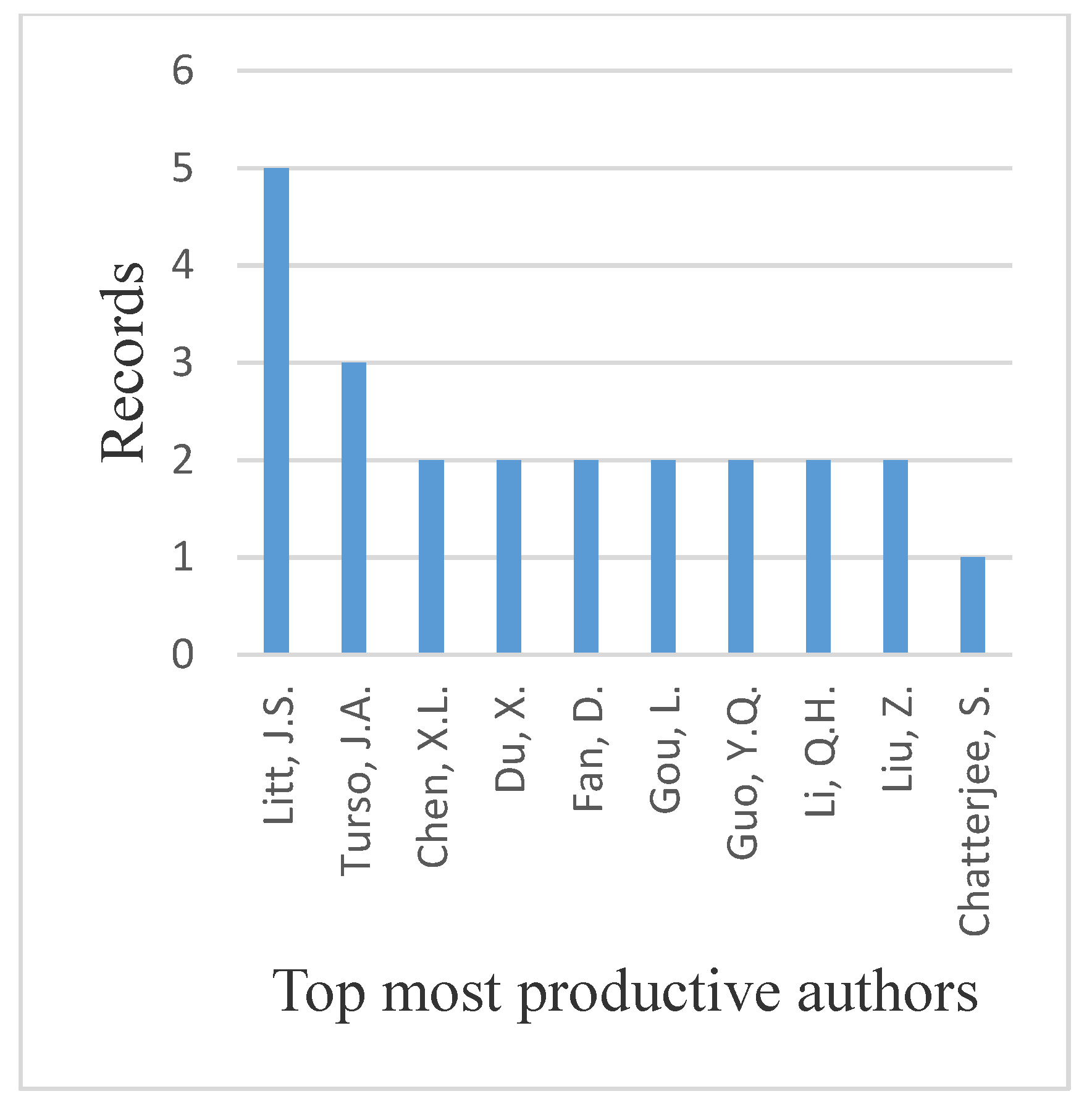

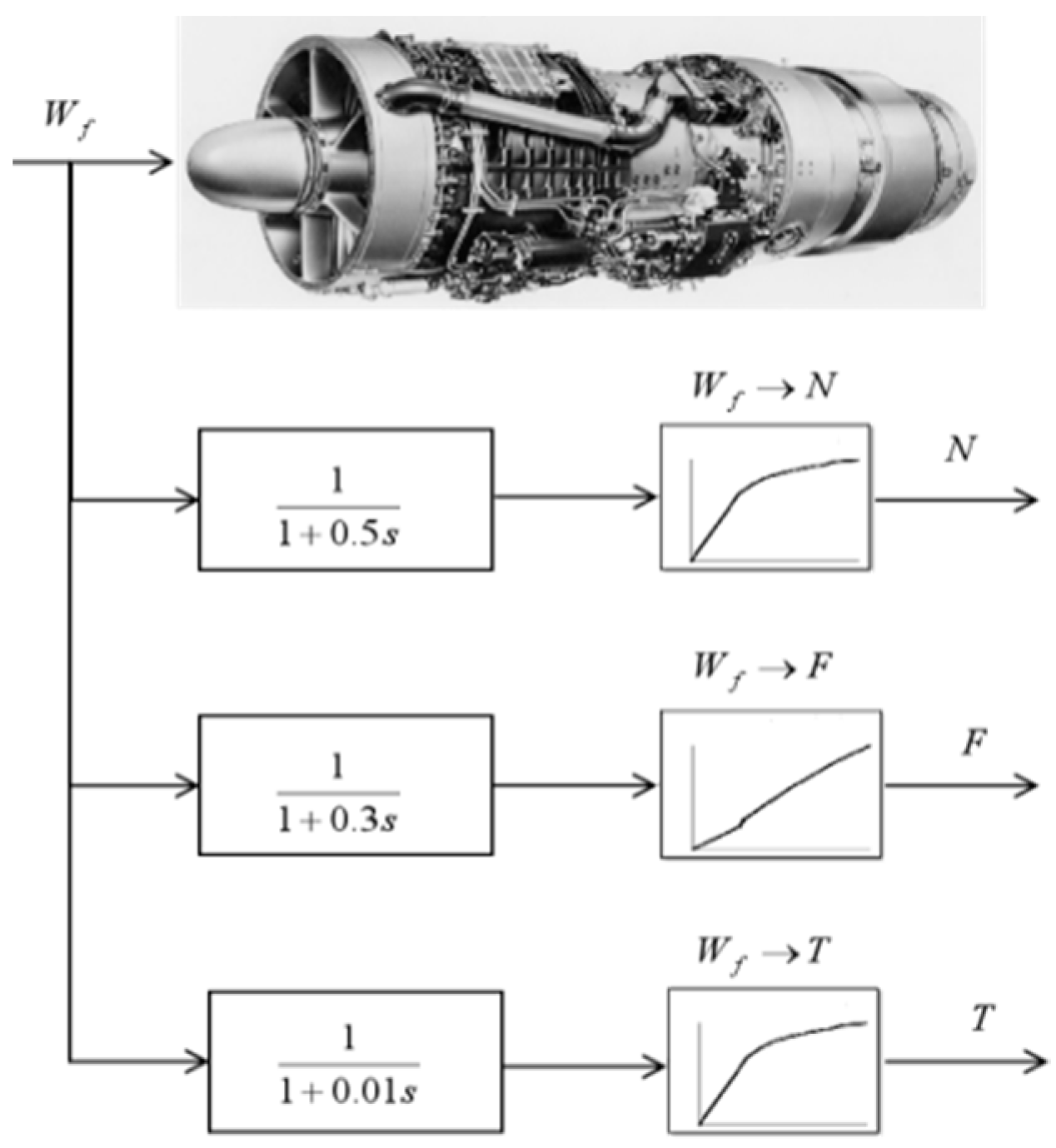



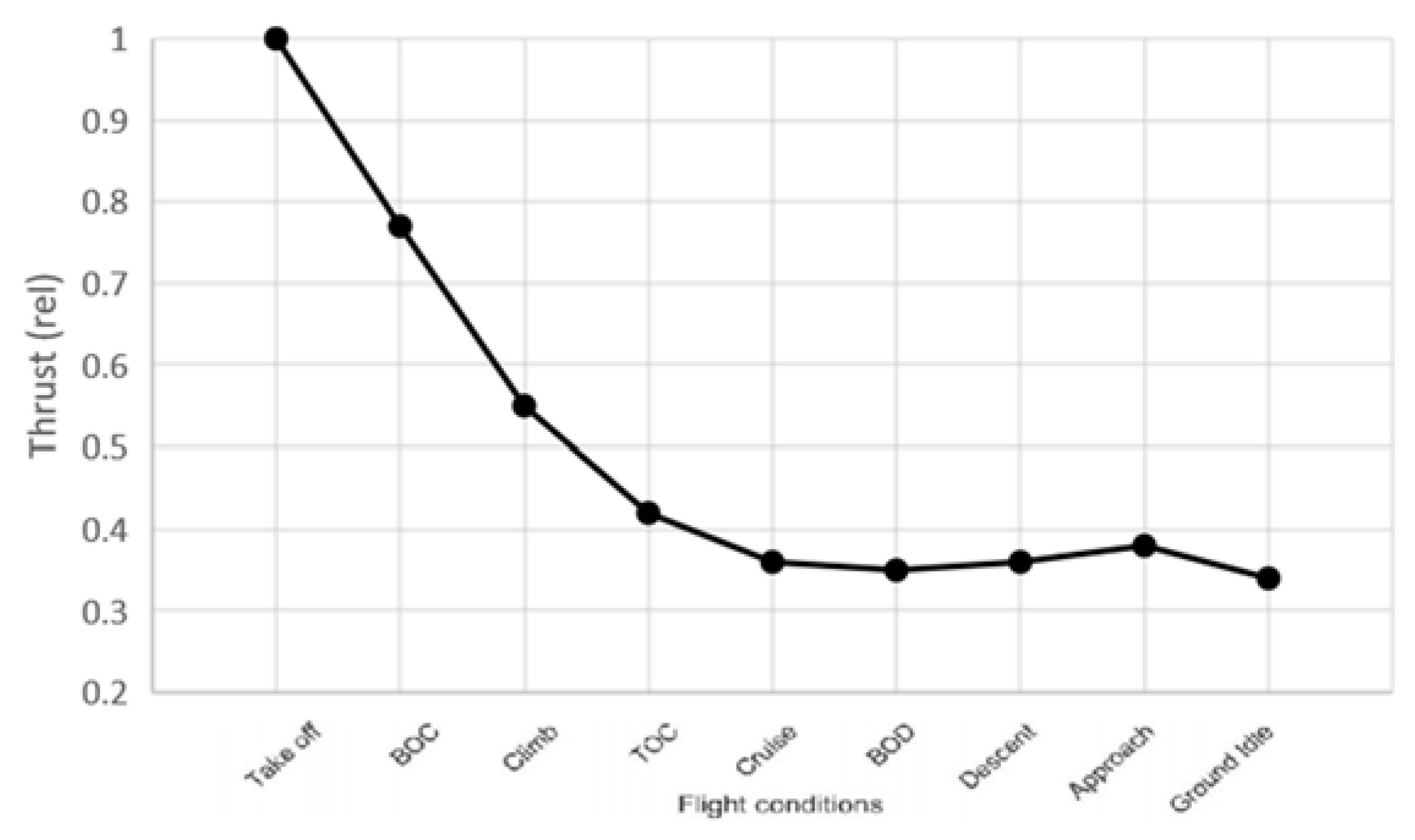
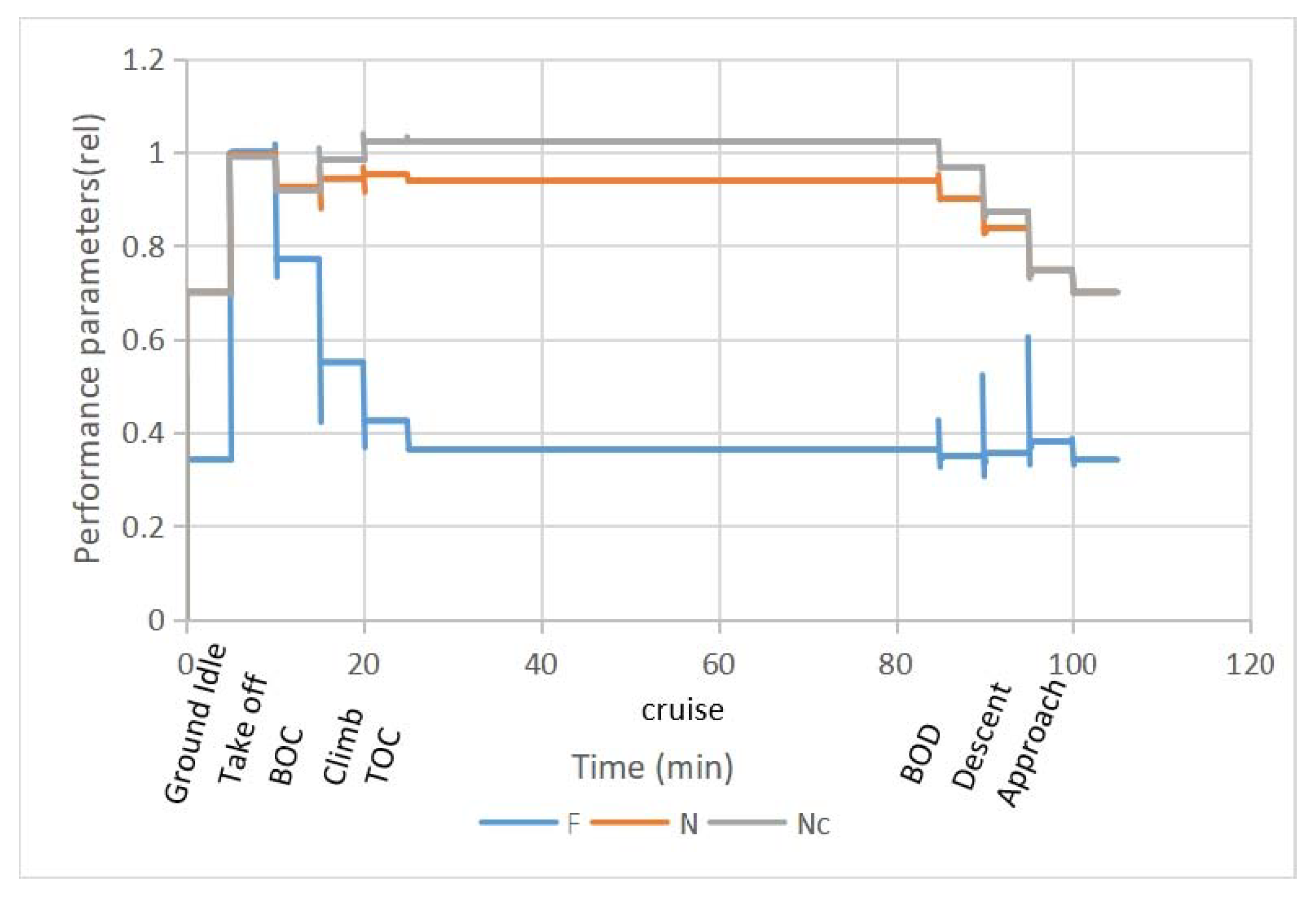

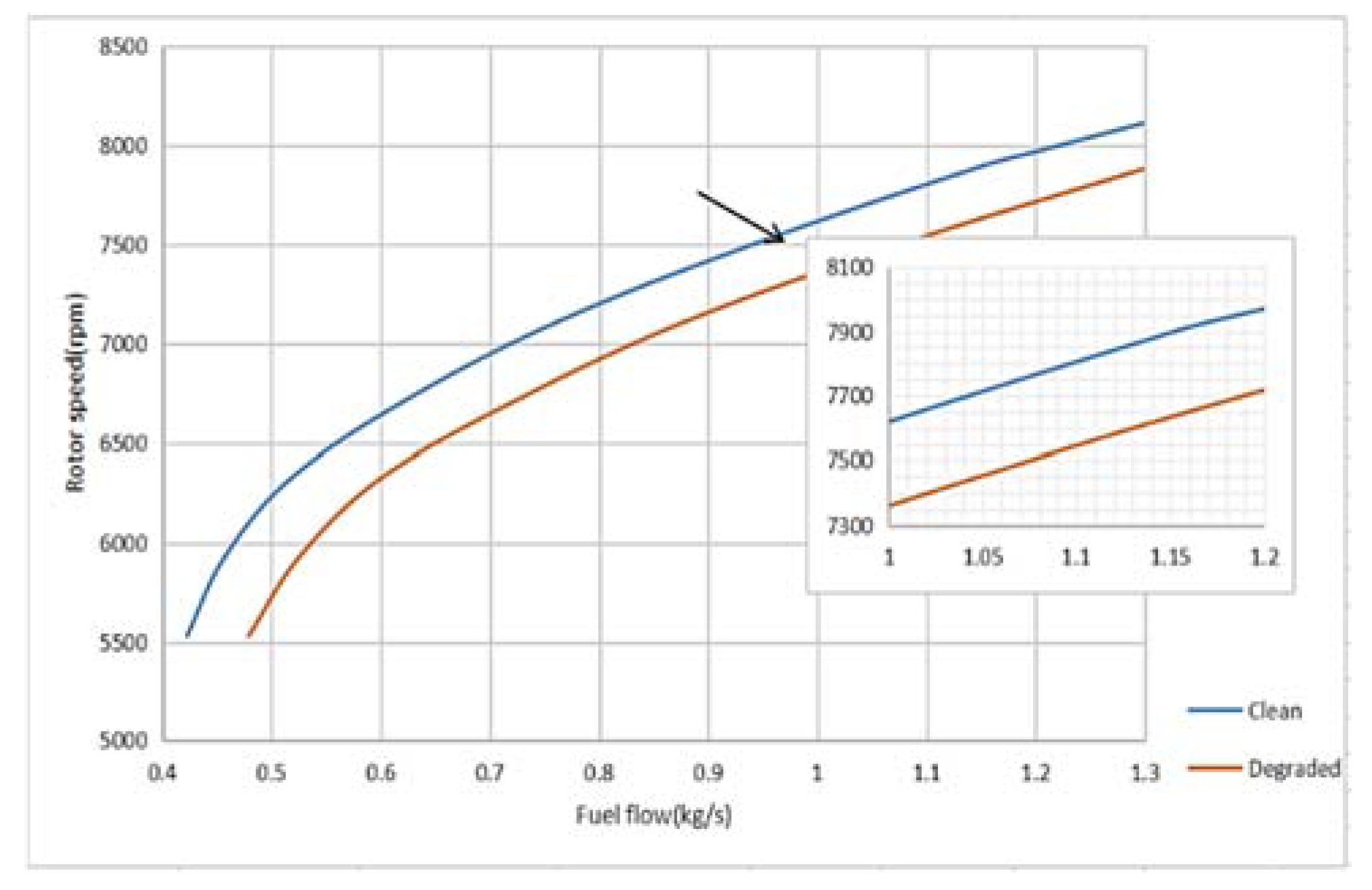
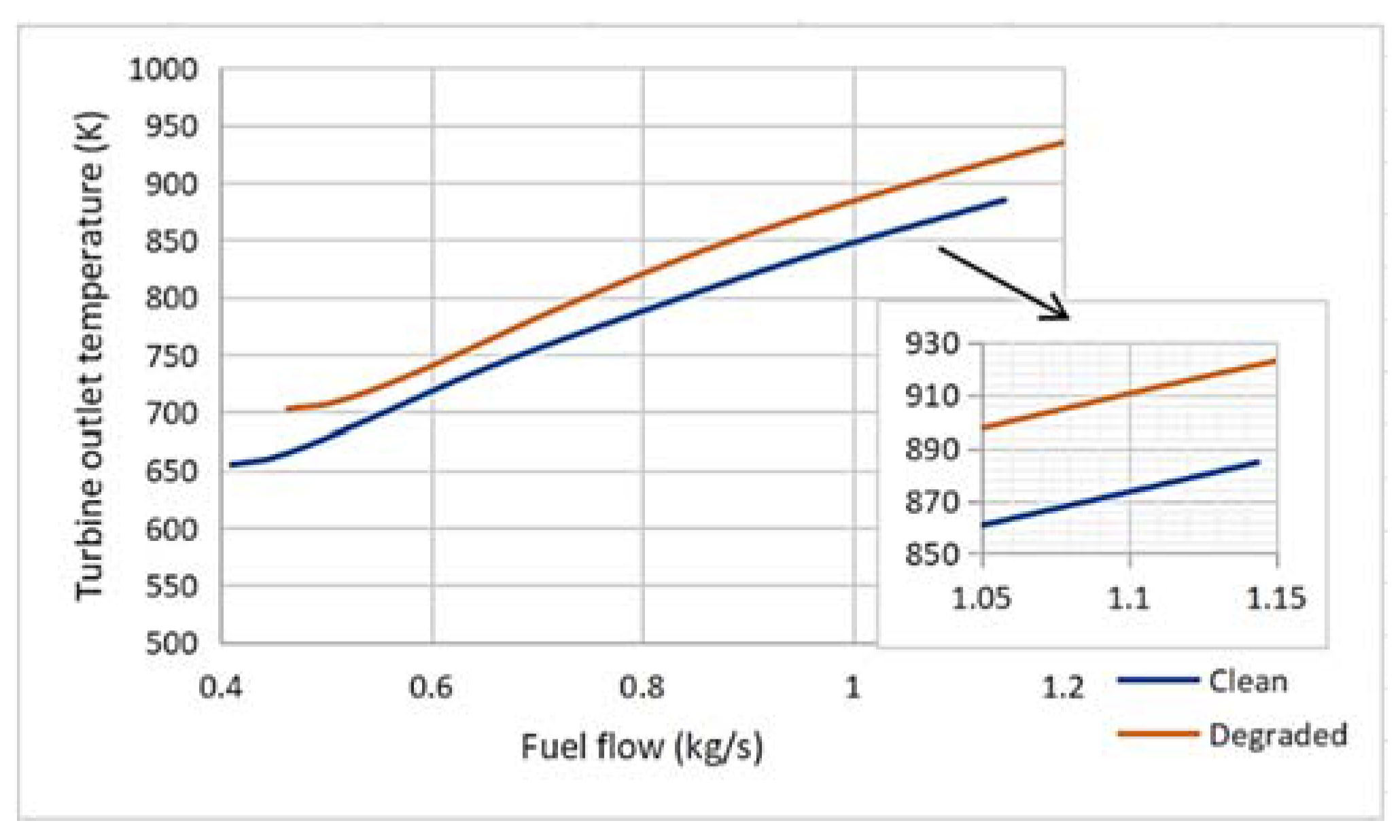




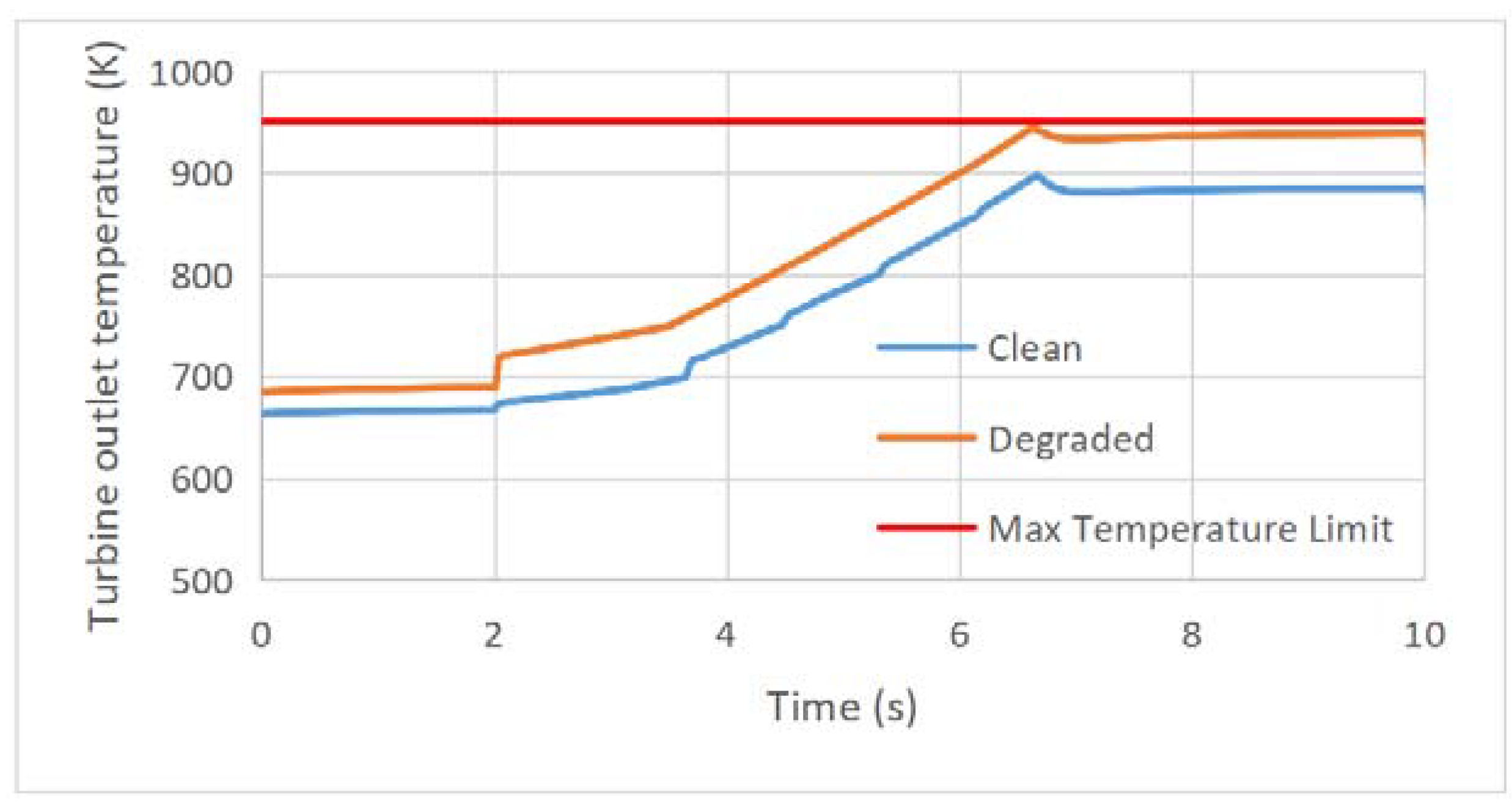

| Keyword | Occurrences |
|---|---|
| Gas Turbines | 1609 |
| Aircraft Engines | 777 |
| Engines | 581 |
| Degradation | 497 |
| Deterioration | 365 |
| Turbomachine Blades | 364 |
| Gases | 276 |
| Compressors | 251 |
| Thermal Barrier Coatings | 222 |
| Performance Degradation | 221 |
| Superalloys | 211 |
| Turbine Components | 200 |
| Oxidation | 188 |
| Keyword | Occurrences |
|---|---|
| Engines | 10 |
| Aircraft Engines | 8 |
| Controllers | 6 |
| Deterioration | 6 |
| Turbofan Engines | 5 |
| Control Systems | 4 |
| Performance Degradation | 4 |
| Performance Deterioration | 4 |
| Adaptive Control Systems | 3 |
| Aero-engine | 3 |
| Engine Performance | 3 |
| Parameters | Values |
|---|---|
| Mass flow (kg/s) | 77.1 |
| Compressor pressure ratio | 8.8 |
| Compressor isentropic efficiency (%) | 88 |
| Combustor outlet temperature (K) | 1141 |
| Turbine isentropic efficiency (%) | 90 |
| Rotor speed (rpm) | 7900 |
| Moment of inertia for the rotor (Nm2) | 20 |
| Performance Parameters | Change (Degraded Engine to Clean Engine) | Influence on the Engine |
|---|---|---|
| Thrust for a given rotor speed | 3000 N higher | - Relationship between rotor speed and thrust (steady-state control mode) - Maximum rotor speed (physical limitations control mode) |
| Rotor speed for a given fuel flow | 250 rpm lower | - Engine model of fuel flow to rotor speed (transient control mode) |
| Turbine outlet temperature for a given fuel flow | 40 K higher | - Engine model of fuel flow to turbine temperature (physical limitation control mode) |
| Turbine outlet temperature for a given thrust | 55 K higher | - Maximum turbine temperature (physical limitation control mode) |
Publisher’s Note: MDPI stays neutral with regard to jurisdictional claims in published maps and institutional affiliations. |
© 2021 by the authors. Licensee MDPI, Basel, Switzerland. This article is an open access article distributed under the terms and conditions of the Creative Commons Attribution (CC BY) license (https://creativecommons.org/licenses/by/4.0/).
Share and Cite
Sun, X.; Jafari, S.; Miran Fashandi, S.A.; Nikolaidis, T. Compressor Degradation Management Strategies for Gas Turbine Aero-Engine Controller Design. Energies 2021, 14, 5711. https://doi.org/10.3390/en14185711
Sun X, Jafari S, Miran Fashandi SA, Nikolaidis T. Compressor Degradation Management Strategies for Gas Turbine Aero-Engine Controller Design. Energies. 2021; 14(18):5711. https://doi.org/10.3390/en14185711
Chicago/Turabian StyleSun, Xiaohuan, Soheil Jafari, Seyed Alireza Miran Fashandi, and Theoklis Nikolaidis. 2021. "Compressor Degradation Management Strategies for Gas Turbine Aero-Engine Controller Design" Energies 14, no. 18: 5711. https://doi.org/10.3390/en14185711
APA StyleSun, X., Jafari, S., Miran Fashandi, S. A., & Nikolaidis, T. (2021). Compressor Degradation Management Strategies for Gas Turbine Aero-Engine Controller Design. Energies, 14(18), 5711. https://doi.org/10.3390/en14185711







